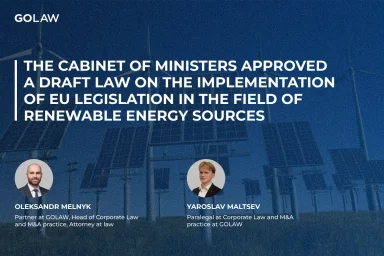Compensation for damage caused by war
Contents
The damage caused by the military aggression of the Russian Federation is already estimated at billions of hryvnias. These include the destruction and damage to citizens’ homes, infrastructure, offices, warehouses, and industrial premises.
Citizens and businesses have a question: who and how will compensate them for the losses?
As of today, there is no single clear mechanism of compensation for the damage caused by Russia’s armed aggression. However, the state has already announced some steps in this direction. The Prime Minister of Ukraine Denys Shmyhal announced the possibility of receiving compensation from the state in the future. He stated that in the application “Diia” it will be possible to register information about the damaged and destroyed property of Ukrainian citizens to obtain compensation for the damage caused by the war. Note that as of the date of this publication, such a function is not yet available in “Diia”.
At this stage, a specific mechanism of compensation for the damage caused by the war has not yet been developed. However, it is already important for victims to properly prepare for future damages.
First of all, it is necessary to check the availability of documents on the ownership of destroyed or damaged property (apartment, house, office, warehouses, and industrial premises). Other documents with the characteristics of the property, such as technical passport, descriptions, drawings, etc., will also be useful.
Next, it is important to gather evidence to further recover damages.
How to record the destruction or damage to property?
We offer the following ways to fix the fact of destruction or damage to property.
1. Individual photo and video recording
A. Turn on the video on your device (phone, camera, or video camera) and clearly name:
- your surname, first name, patronymic;
- passport data and ITIN (if possible);
- date and time of recording (we also recommend recording the video screen of another device, which will indicate the date and time of recording, such as a watch);
- exact location (settlement, street, house number).
B. Point the camera at yourself to record that you are filming. If you are filming with other people, record such people and information about them on video.
С. Take a video of the destruction/damage, during which you describe in words all the information you have. Indicate the date, time, and all known circumstances of damage/destruction of property, information about the owner of the property. In addition to video, it is recommended to take detailed photos of damage/destruction.
Such recording can be made by the owner of the property, as well as by any other person who can later become a witness and personally confirm the circumstances of damage/destruction of the property.
!!! Before taking an individual photo and video recording, make sure it is safe for your life and health !!!
2. Drawing up a document with the participation of witnesses
Others may have witnessed the destruction or damage of property. In this case, it is necessary to state in a written document (protocol, act) signed by such witnesses information known to them (date, time, and all known circumstances of damage/destruction of property, information about the owner of the property).
The protocol/act is drawn up in any form but must contain information about the date, time, and place of its preparation, passport data, residence, and contact information of persons signing such a document. Witnesses may also provide written explanations regarding the circumstances of the damage/destruction they know.
If there were CCTV cameras near your property that could record the moment the projectile hit, fire, etc., try to obtain recordings from such cameras for further use as evidence.
3. Preparation of documents with the participation of competent authorities
If possible, we recommend calling representatives of the relevant district state administration, local governments to draw up an act on the destruction/damage of property.
In case of fires and accidents, as a rule, representatives of the State Emergency Service go to the scene of the accident. They can also draw up an act on the fire indicating its cause (shelling, bombing). Make sure you get a copy of this act.
It is also necessary to call the police to draw up a police report, which will record the destruction/damage to property. It is also needed to submit a statement of crime to law enforcement agencies and obtain an extract from the Unified Register of pre-trial Investigations. In the framework of criminal proceedings, further investigative actions may be carried out, examinations may be ordered to establish the causes of damage, the circumstances of their occurrence, and the assessment of economic losses.
4. Collection of materials published in the media
If the media, online publications, telegram channels covered the circumstances of the destruction or damage to your property, you should save such publications, take screenshots, etc. Further such materials will be an additional argument to confirm the fact of destruction/damage to property.
Additionally, you can download the collected evidence on the websites https://warcrimes.gov.ua/, https://tribunal.in.ua/. In this case, this evidence will also be used to prosecute those involved in crimes under Ukrainian law, as well as in the International Criminal Court in The Hague and a special tribunal after its establishment.
Evidence gathered: what’s next?
At the moment, we consider that appeal to the court with a claim for damages will not lead to a real result. However, there is no alternative administrative procedure on this issue.
As noted above, the mechanism of compensation for damage caused by the war has not yet been established. The Government has announced the creation of a special Destroyed Property and Infrastructure Restoration Fund in the future and the registration of information on damaged and destroyed property of Ukrainian citizens in the application “Diia”. However, the question remains whether legal entities will be able to receive compensation from the Fund, or whether the funds will be directed exclusively to the needs of citizens whose homes were destroyed or damaged by the occupier.
It should be noted that the Resolution of the Cabinet of Ministers of Ukraine of March 20, 2022, № 326 approved the Procedure for determining the damage and losses caused to Ukraine as a result of the armed aggression of the Russian Federation. However, the just-adopted legal act only determines the directions in which methods will be developed to assess the damage and losses caused by the aggression of the Russian Federation. For example, the direction of “economic losses of enterprises” will include losses of enterprises of all forms of ownership due to the destruction and damage of their property, as well as lost profits from the inability or obstacles to doing business. Relevant ministries must develop and approve such methodologies within 6 months.
Recovery of damages: previous experience
Ukraine has already suffered from Russian aggression in Donetsk and Luhansk regions. However, at the legislative level, no effective mechanism has been introduced to compensate for the damage caused to citizens and businesses in these areas. Thus, in 2014, an anti-terrorist operation was announced in Donetsk and Luhansk regions. Therefore, the issue of compensation for damages was regulated, in particular, by the Law of Ukraine “On Combating Terrorism”. This Law stipulates that compensation for damage is carried out at the expense of the state budget of Ukraine.
Further, in 2018 the Law of Ukraine “On particular aspects of public policy aimed at safeguarding state sovereignty of Ukraine over the temporarily occupied territory of Donetsk and Luhansk regions” was adopted. The law provides for the possibility of involving the aggressor country Russian Federation as a defendant in court cases on damages. However, in practice, such a remedy proved ineffective given Russia’s immunity from decisions of Ukrainian national courts.
Therefore, the possibility of compensation for material damage was provided only declaratively. In turn, there was no effective mechanism for implementing these provisions and real compensation for damages. That’s why most citizens and businesses whose property was destroyed as a result of Russian aggression in eastern Ukraine have not achieved real protection of their rights.
Conclusion
Thus, citizens and businesses expect the state to develop methods for determining and a clear procedure for compensation for damage to their property. And while there is no effective mechanism for recovering damages, it is worth focusing on the formation of an appropriate evidence base to confirm the fact of damage/destruction of property.

Kateryna Tsvetkova
Partner, Litigation and Dispute Resolution practice, Attorney at law
- Contacts
- 31/33 Kniaziv Ostrozkykh St, Zorianyi Business Center, Kyiv, Ukraine, 01010
- k.tsvetkova@golaw.ua
- +38 044 581 1220
- Recognitions
- Lexology Index: Client Choice 2026
- Lexology Index: Employment & Labor 2025
- The Legal 500 EMEA 2025
- Lexology Index: Restructuring & Insolvency 2026
Related insights

16 December 2025 Publication
The Cabinet of Ministers approved a draft law on the implementation of EU legisl...

12 December 2025 Publication
Seizure of assets in foreign banks: legal ways to protect your interests

08 December 2025 Publication
How not to lose money and corporate rights when selling a share in the authorise...
Sign up to be aware
New achievements are inspired by information. GO further, don’t miss out GOLAW news and legal alerts
Our expertise
- Energy and Natural Resources
- Antitrust and Competition
- Banking and Finance
- Compliance, Corporate Governance and Risk Management
- Corporate and M&A
- Criminal and White Collar Defence
- Defense in Anti-corruption procedures and regulations
- Labor and Employment
- Natural Resources and Environment
- Government Relations (GR)
- Insolvency and Corporate Recovery
- Intellectual property
- International trade
- Legal support of business and private Сlients in Germany
- Litigation and dispute resolution
- Private clients
- Real Estate and Construction
- Restructuring, Claims and Recoveries
- Martial Law
- Tax and Customs
- Agribusiness
- Aviation
- Chemical industry
- Engineering, Construction and Building Materials
- Environment and Natural Resources
- Financial institutions
- IT and AI
- Industry and manufacturing
- Healthcare industries, Life sciences and Pharmaceuticals
- Media, Entertainment, Sports and Gambling
- Retail, FMCG and E-Commerce
- Transport and Logistics
We use cookies to improve performance of our website and your user experience.
Cookies policy
Cookies settings




